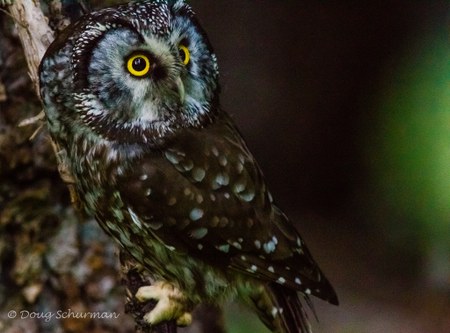
Have you ever been hiking alone and felt like you were being watched? It’s quite possible you were under observation - by a stealthy owl, perched above you in a tree. Often heard but not seen in our forests, these amazing birds of prey can swoop down silently, blending in with the trees they inhabit.
While many people in our state may go their entire lives without seeing an owl, there are actually more than a dozen different species that call Washington home. The most common (and the most distinguishable due to its signature “horns”) is the Great Horned Owl, but Barred Owls, Barn Owls, and Burrowing Owls are among the other species that can also be found in our state.
The life of an owl
Owls can feed on small mammals, birds, and sometimes fish, but their diets primarily consist of small animals like rodents. When an owl has its dinner, it ingests the entire animal: bones and all. After mealtime is over the owl will regurgitate that which it couldn’t digest, including bones and fur. These regurgitated masses are called “owl pellets,” and can often be found below an owl’s favorite roosting spot.
Many - but not all - owls are nocturnal. Night means cooler temperatures and more cover from predators, and much of their prey tends to be more active at night. Owls have special adaptations for hunting in the dark, including excellent night vision and a very sophisticated auditory system.
Owls’ ears are located on the front of their faces, and are asymmetrical, which allows them to hunt primarily by sound. They can pinpoint the exact location of their prey based on the smallest rustle of a leaf. Their signature disc-shaped faces also act as kind of a “satellite” for receiving sound.
Most of these enchanting animals roost and nest high up in buildings (such as barns) or in trees, often where a branch meets the trunk or in tree holes. They almost always repurpose nests built by other birds, as they themselves are not great nest-makers. A few species like the Burrowing Owl nest near the ground.
Tips for spotting owls
As many owls are nocturnal, to have the best chance of viewing one you’ll need to go on an “owl prowl” after nightfall. Don’t forget to bring a headlamp or flashlight. Even during the light of day owls are pretty hard to spot, as they prefer to hang out in dense forests. Camouflaged, they silently stalk their prey while waiting for the right moment to attack.
Because owls sometimes roost or nest in deciduous trees, they might be easier to spot in winter, tucked between the bare branches. Keep an eye out for owl nests, as this usually means that the owl is somewhere nearby.
Another clue involves looking down at the ground rather than up in the trees. Because owls tend to have favorite roosting spots, if you can find areas where the ground is covered in owl excrement (which is white, and easy to spot) or owl pellets, you may just spot the bird above responsible for the mess.
If you’re lucky enough to spot an owl, remember not to bother it! While they are fascinating animals, they have been known to occasionally “dive-bomb” people when they believe that their territory or young are threatened. We can emulate the fabled wise old owl by respecting wildlife and simply finding wisdom and joy in their presence, safely tucked away in the high trees.
If you’re interested in learning more about owls or other types of birds, look for upcoming birding courses on our website, mountaineers.org. Many local Audubon chapters also offer “Owl Prowls” for birders hoping to glimpse these nocturnal animals.
This article originally appeared in our Spring 2021 issue of Mountaineer Magazine. To view the original article in magazine form and read more stories from our publication, visit our magazine archive.
 Tiffany Ban
Tiffany Ban